How Do Mourning Cloak Butterflies Eat?
Mourning Cloak butterflies (Nymphalis antiopa) primarily feed on tree sap, particularly from willows, oaks, and maples, leveraging its carbohydrate and mineral content for metabolic functions. They also consume honeydew, a sugar-rich excretion from aphids, and turn to rotting fruit when sap is unavailable.
Essential nutrients are obtained from animal droppings, providing vital salts and minerals, and they also ingest tree bark for its rich carbohydrate content. Flower nectar, particularly from milkweed and lilac, supplements their diet, as does pollen.
Larvae feed on decaying plant material, significant for their growth. Learn about their unique dietary adaptations and behaviors further.
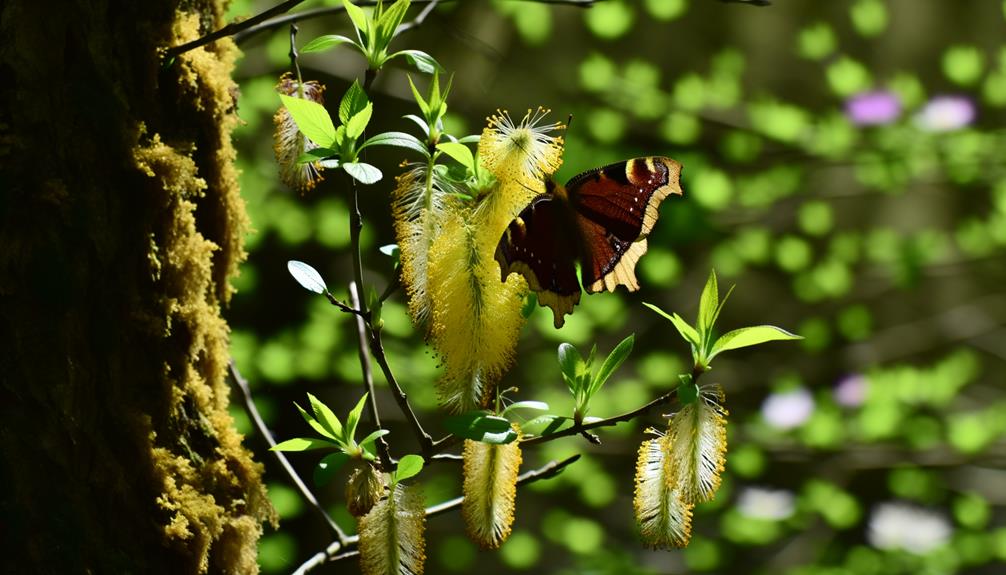
Key Takeaways
- Mourning Cloak butterflies consume tree sap, especially from willows, oaks, and maples, for essential carbohydrates.
- They feed on honeydew excreted by aphids, providing a sugar-rich energy source.
- Rotting fruit serves as an alternative food source, offering high sugar content for energy.
- Animal droppings provide essential minerals and salts, aiding in osmoregulation and nerve function.
Tree Sap

Mourning Cloak butterflies (Nymphalis antiopa) mainly rely on tree sap as a primary food source during their adult stage. This reliance is particularly significant in early spring when floral nectar is scarce.
Tree sap, primarily from willows, oaks, and maples, provides essential carbohydrates and nutrients necessary for their survival and reproductive success. Empirical studies indicate that the sugar concentration in tree sap can range from 2% to 5%, offering a substantial energy source.
Additionally, the sap contains amino acids and minerals, which are critical for maintaining metabolic functions. This dietary adaptation allows Mourning Cloaks to thrive in habitats where other nectar sources are limited, thereby ensuring their persistence across diverse ecological zones.
Rotting Fruit
Rotting fruit serves as an alternative nutritional source for Nymphalis antiopa, providing essential sugars and other nutrients when tree sap is not readily available.
This adaptive feeding behavior allows the Mourning Cloak butterfly to exploit various ecological niches, ensuring survival across different environments. The fermentation process in decaying fruit breaks down complex sugars into simpler forms, which are easier for butterflies to digest and assimilate.
Key benefits of rotting fruit consumption include:
- High sugar content: Provides immediate energy necessary for flight and metabolic activities.
- Fermentation byproducts: Offers additional nutrients like alcohols and acids.
- Availability: Often more accessible than other food sources in certain habitats.
This dietary flexibility underscores Nymphalis antiopa's resilience and adaptability.
Animal Droppings
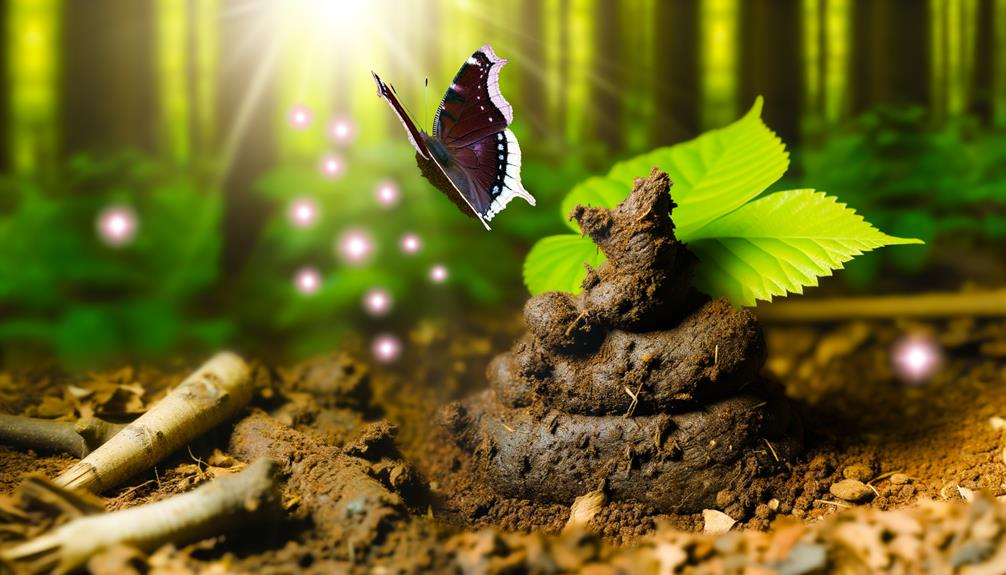
Animal droppings serve as an important nutrient source for Nymphalis antiopa, providing essential minerals and salts that are otherwise scarce in their primary diet.
These excrements contain essential nutrients such as sodium and potassium, which are important for physiological functions including osmoregulation and nerve impulse transmission.
Empirical studies have demonstrated that Mourning Cloak butterflies exhibit a marked preference for animal feces, attracted by the high concentration of electrolytes. This behavior underscores an adaptive foraging strategy to supplement their nutritional intake.
In addition, the consumption of animal droppings aids in reproductive success as these minerals are fundamental for egg development and viability.
Therefore, animal droppings play a pivotal role in sustaining the health and reproductive capabilities of Nymphalis antiopa.
Tree Bark
Tree bark serves as an essential nutritional source for Mourning Cloak butterflies (Nymphalis antiopa), providing important carbohydrates and minerals.
Observational data indicate that these butterflies exhibit specific feeding behaviors, utilizing their proboscis to extract sap from tree bark.
This sap consumption is particularly critical during periods of scarcity when other food sources are limited.
Nutritional Benefits
The nutritional benefits of tree bark for Mourning Cloak butterflies primarily derive from its high concentration of essential minerals and nutrients.
These nutrients are essential for their survival and reproductive success, enhancing their physiological functions and overall health.
Tree bark serves as a significant source of:
- Calcium: Essential for the development of strong exoskeleton structures.
- Potassium: Important for maintaining cellular functions and electrolyte balance.
- Magnesium: Plays a pivotal role in enzyme activation and photosynthetic processes in plants, indirectly benefitting the butterflies.
Feeding Behavior
Adopting a unique feeding strategy, Mourning Cloak butterflies utilize their specialized proboscises to extract nutrients from tree bark, primarily during early spring when other food sources are scarce.
This behavior is facilitated by their ability to penetrate the bark and access the sap, which is rich in sugars and amino acids essential for their survival. Research indicates that the sap-feeding period coincides with the thawing of tree sap flow, typically occurring when temperatures rise above freezing.
The Mourning Cloak's reliance on tree bark underscores their adaptability in nutrient acquisition, allowing them to thrive in temperate regions.
This feeding behavior also provides a competitive edge, minimizing direct competition with other nectar-feeding insects during resource-limited periods.
Flower Nectar

Mourning Cloak butterflies (Nymphalis antiopa) are known to exhibit specific preferences for certain flower types, particularly those that offer abundant nectar.
Seasonal variations greatly impact the availability of these nectar sources, influencing their feeding behavior and migration patterns.
Studies indicate that these butterflies demonstrate distinct foraging strategies, optimizing nectar intake based on floral abundance and phenology.
Preferred Flower Types
Nymphalis antiopa exhibits a notable preference for nectar from flowers such as milkweed, lilac, and sap-producing trees. This selection is not arbitrary; it reflects the specific nutritional and ecological requirements of the Mourning Cloak butterfly.
These flower types are characterized by:
- High nectar concentration: Ensuring sustained energy levels for flight and reproduction.
- Accessibility of nectar: Facilitating efficient feeding due to the butterfly's proboscis structure.
- Pervasiveness in their habitats: Aligning with the geographical distribution of N. antiopa.
Research indicates that these preferences optimize energy intake and support the butterfly's complex life cycle.
Consequently, the Mourning Cloak's selective feeding behavior underscores an evolutionary adaptation to its ecological niche.
Seasonal Nectar Sources
Throughout the year, Mourning Cloak butterflies rely on a variety of floral nectar sources that fluctuate with seasonal changes, ensuring a continual supply of essential nutrients.
In early spring, they mainly feed on nectar from early-blooming flowers such as willow (Salix spp.) and maple (Acer spp.).
As the season progresses into summer, they shift to nectar from flowering plants like milkweed (Asclepias spp.) and aster (Asteraceae).
In autumn, goldenrod (Solidago spp.) and late-blooming asters provide critical nectar sources.
These seasonal shifts in nectar sources are crucial for maintaining their energy levels and reproductive fitness.
Understanding these temporal patterns aids in conservation efforts, ensuring the preservation of their habitats and the floral diversity they depend on.
Feeding Behavior Patterns
Feeding behavior patterns of Mourning Cloak butterflies exhibit a distinct preference for high-sugar floral nectars, optimizing energy intake for sustained flight and reproduction. This preference is critical for maintaining their physiological functions, including thermoregulation and muscle performance.
Empirical data reveal their affinity for specific flowering plants, where nectar composition plays a pivotal role in their foraging choices. Key nectar sources include:
- Salix spp. (willows)
- Acer spp. (maples)
- Prunus spp. (cherries)
These floral sources provide essential carbohydrates, enabling Mourning Cloak butterflies to efficiently manage their energy reserves.
Their foraging strategy demonstrates a sophisticated adaptation to their ecological niche, ensuring survival and reproductive success in diverse habitats. This selective feeding behavior underscores their role in ecosystem pollination dynamics.
Decaying Plant Material
Decaying plant material serves as an essential nutrient source for Mourning Cloak butterflies, particularly during early larval stages. This detritus is rich in nitrogen, a critical component for larval growth and development.
Studies indicate that larvae consuming decayed leaves exhibit accelerated growth rates and higher survival probabilities. Decomposed plant matter also provides a stable microenvironment, shielding larvae from predation and harsh climatic conditions.
This ecological niche supports microbial activity, which further enhances nutrient availability. Such a nutrient-dense diet guarantees the larvae's robust development into resilient adults.
Understanding the reliance of Mourning Cloak larvae on decaying plant material underscores the importance of preserving natural habitats where organic matter can accumulate and degrade effectively, promoting the species' life cycle sustainability.
Pollen
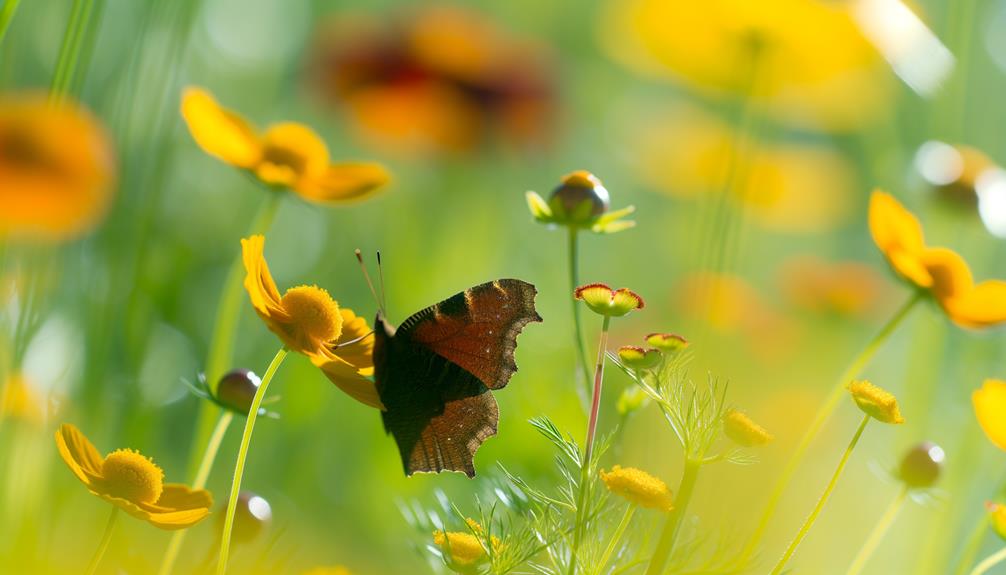
Pollen constitutes a significant dietary component for Mourning Cloak butterflies, particularly during their adult stage, providing essential proteins and lipids necessary for energy and reproduction.
These butterflies exhibit a keen preference for certain pollen types, which are fundamental for their sustenance and overall fitness.
Notable attributes of pollen in the diet of Mourning Cloak butterflies include:
- Nutritional Composition: High in proteins and lipids, essential for metabolic functions.
- Source Variety: Derived from diverse flowering plants, ensuring dietary diversity.
- Seasonal Availability: Accessible during peak flowering periods, aligning with reproductive cycles.
Understanding these dietary preferences aids in habitat conservation and species survival strategies.
Honeydew
In addition to pollen, Mourning Cloak butterflies frequently consume honeydew, a sugar-rich excretion produced by aphids and other phloem-feeding insects.
This nutrient-dense resource is rich in carbohydrates, providing a critical energy source for their metabolic needs. Research indicates that honeydew contributes considerably to their sustenance, especially in environments where floral nectar is scarce.
The ingestion of honeydew has been linked to enhanced flight endurance and reproductive success in Mourning Cloak butterflies. Additionally, its consumption supports the maintenance of their immune system, aiding in resilience against pathogens.
This feeding behavior underscores the adaptability of Mourning Cloak butterflies in exploiting diverse nutritional sources, thereby ensuring their survival and ecological success in varying habitats. Their ability to utilize tree sap, rotting fruit, and even animal dung highlights their resourcefulness in obtaining essential nutrients. This contrasts with the more specialized requirements of other species, such as the queen alexandra birdwing habitat, which is limited to specific rainforest regions. Such adaptability allows Mourning Cloak butterflies to thrive in temperate forests, urban areas, and even suburban gardens.
Moisture Sources
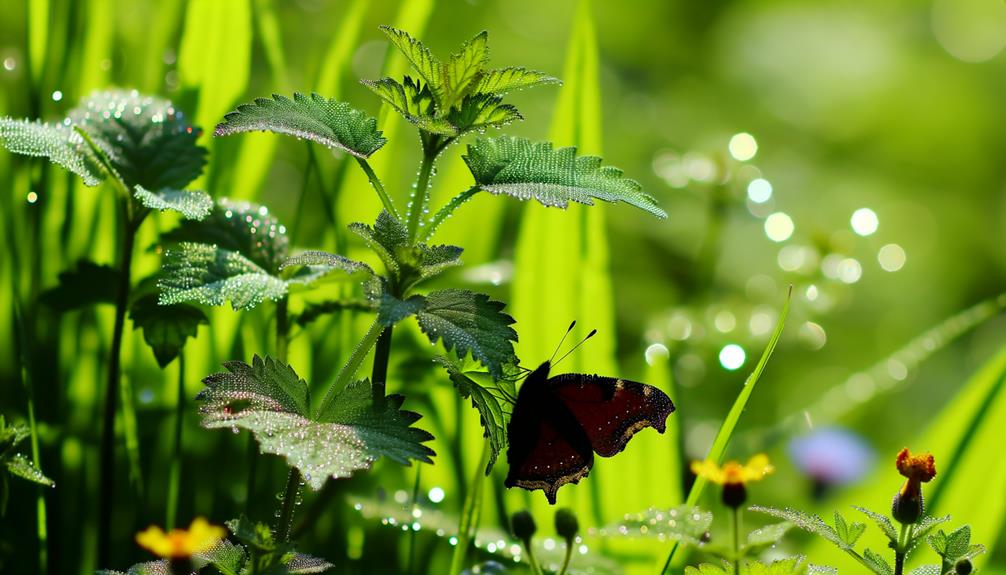
Accessing adequate moisture is vital for Mourning Cloak butterflies, as it plays an essential role in their physiological processes and overall survival. These butterflies obtain moisture from various environmental sources, which facilitate hydration and nutrient acquisition.
Key moisture sources include:
- Dew on Vegetation: Early morning dew provides a significant hydration source for these butterflies.
- Puddling: Engaging in puddling behavior, Mourning Cloaks absorb minerals and salts from moist ground or mud.
- Tree Sap: Sap from wounded trees offers both moisture and essential nutrients.
These hydration methods are indispensable for maintaining their metabolic functions, aiding in thermoregulation, and supporting their longevity in diverse habitats.
Conclusion
The dietary preferences of Mourning Cloak butterflies encompass a variety of organic materials, including tree sap, rotting fruit, and animal droppings.
Coincidentally, these butterflies also consume tree bark, flower nectar, and decaying plant material.
Additionally, they derive nutrients from pollen, honeydew, and various moisture sources.
This diverse diet not only supports their survival but also contributes to the ecological balance by facilitating nutrient cycling and pollination.
This multifaceted feeding behavior underscores the interconnectedness of ecosystem components.



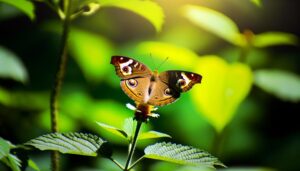
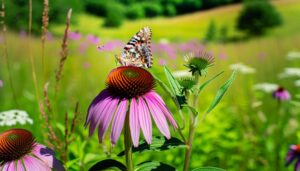
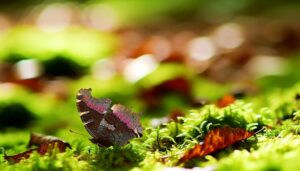

I’m really inspired with your writing skills and also with the format in your blog.
Is this a paid subject matter or did you modify it your self?
Either way keep up the excellent high quality writing,
it is rare to look a nice blog like this one nowadays..
Feel free to surf to my page – Nordvpn Coupons inspiresensation (t.co)
Awesome! Its really amazing article, I have got much clear
idea concerning from this piece of writing.
Here is my page :: nordvpn Coupons inspiresensation
I like the valuable information you provide in your articles.
I’ll bookmark your weblog and check again here frequently.
I’m quite certain I’ll learn a lot of new stuff right here!
Best of luck for the next!
Feel free to visit my site :: nordvpn coupons inspiresensation (cia.sh)
Having read this I believed it was rather informative.
I appreciate you taking the time and effort to put this information together.
I once again find myself personally spending way too much time both reading and commenting.
But so what, it was still worth it!
Also visit my webpage :: Nordvpn coupons inspiresensation (T.co)